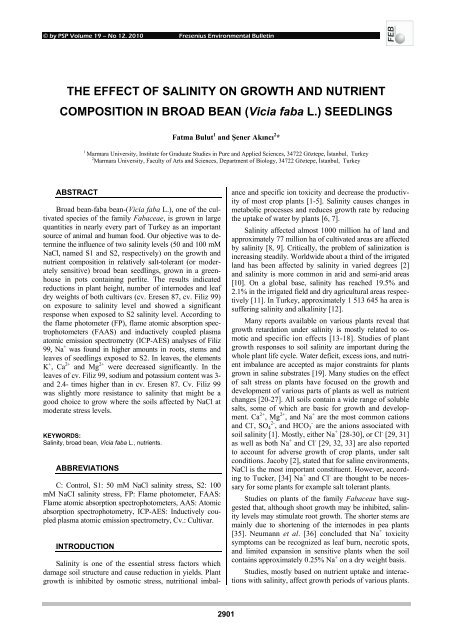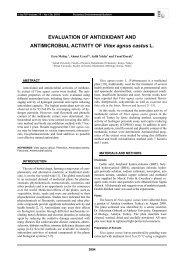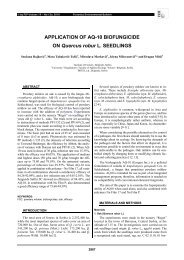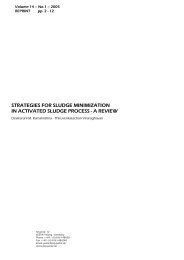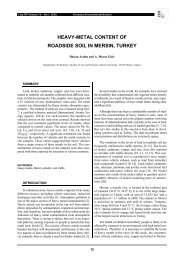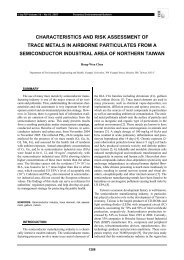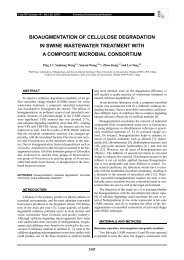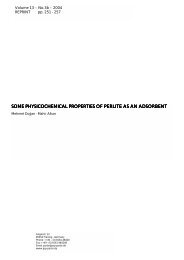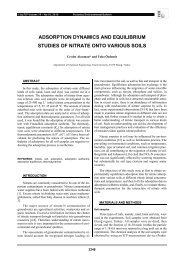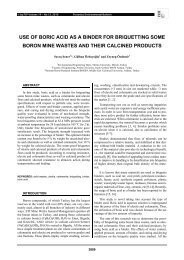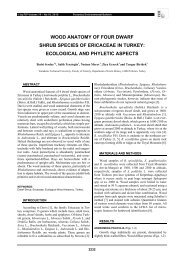THE EFFECT OF SALINITY ON GROWTH AND NUTRIENT ...
THE EFFECT OF SALINITY ON GROWTH AND NUTRIENT ...
THE EFFECT OF SALINITY ON GROWTH AND NUTRIENT ...
Create successful ePaper yourself
Turn your PDF publications into a flip-book with our unique Google optimized e-Paper software.
© by PSP Volume 19 – No 12. 2010 Fresenius Environmental Bulletin<br />
<strong>THE</strong> <strong>EFFECT</strong> <strong>OF</strong> <strong>SALINITY</strong> <strong>ON</strong> <strong>GROWTH</strong> <strong>AND</strong> <strong>NUTRIENT</strong><br />
COMPOSITI<strong>ON</strong> IN BROAD BEAN (Vicia faba L.) SEEDLINGS<br />
Fatma Bulut 1 and Şener Akıncı 2 *<br />
1<br />
Marmara University, Institute for Graduate Studies in Pure and Applied Sciences, 34722 Göztepe, İstanbul, Turkey<br />
2 Marmara University, Faculty of Arts and Sciences, Department of Biology, 34722 Göztepe, İstanbul, Turkey<br />
ABSTRACT<br />
Broad bean-faba bean-(Vicia faba L.), one of the cultivated<br />
species of the family Fabaceae, is grown in large<br />
quantities in nearly every part of Turkey as an important<br />
source of animal and human food. Our objective was to determine<br />
the influence of two salinity levels (50 and 100 mM<br />
NaCl, named S1 and S2, respectively) on the growth and<br />
nutrient composition in relatively salt-tolerant (or moderately<br />
sensitive) broad bean seedlings, grown in a greenhouse<br />
in pots containing perlite. The results indicated<br />
reductions in plant height, number of internodes and leaf<br />
dry weights of both cultivars (cv. Eresen 87, cv. Filiz 99)<br />
on exposure to salinity level and showed a significant<br />
response when exposed to S2 salinity level. According to<br />
the flame photometer (FP), flame atomic absorption spectrophotometers<br />
(FAAS) and inductively coupled plasma<br />
atomic emission spectrometry (ICP-AES) analyses of Filiz<br />
99, Na + was found in higher amounts in roots, stems and<br />
leaves of seedlings exposed to S2. In leaves, the elements<br />
K + , Ca 2+ and Mg 2+ were decreased significantly. In the<br />
leaves of cv. Filiz 99, sodium and potassium content was 3-<br />
and 2.4- times higher than in cv. Eresen 87. Cv. Filiz 99<br />
was slightly more resistance to salinity that might be a<br />
good choice to grow where the soils affected by NaCl at<br />
moderate stress levels.<br />
KEYWORDS:<br />
Salinity, broad bean, Vicia faba L., nutrients.<br />
ABBREVIATI<strong>ON</strong>S<br />
C: Control, S1: 50 mM NaCl salinity stress, S2: 100<br />
mM NaCI salinity stress, FP: Flame photometer, FAAS:<br />
Flame atomic absorption spectrophotometers, AAS: Atomic<br />
absorption spectrophotometry, ICP-AES: Inductively coupled<br />
plasma atomic emission spectrometry, Cv.: Cultivar.<br />
INTRODUCTI<strong>ON</strong><br />
Salinity is one of the essential stress factors which<br />
damage soil structure and cause reduction in yields. Plant<br />
growth is inhibited by osmotic stress, nutritional imbalance<br />
and specific ion toxicity and decrease the productivity<br />
of most crop plants [1-5]. Salinity causes changes in<br />
metabolic processes and reduces growth rate by reducing<br />
the uptake of water by plants [6, 7].<br />
Salinity affected almost 1000 million ha of land and<br />
approximately 77 million ha of cultivated areas are affected<br />
by salinity [8, 9]. Critically, the problem of salinization is<br />
increasing steadily. Worldwide about a third of the irrigated<br />
land has been affected by salinity in varied degrees [2]<br />
and salinity is more common in arid and semi-arid areas<br />
[10]. On a global base, salinity has reached 19.5% and<br />
2.1% in the irrigated field and dry agricultural areas respectively<br />
[11]. In Turkey, approximately 1 513 645 ha area is<br />
suffering salinity and alkalinity [12].<br />
Many reports available on various plants reveal that<br />
growth retardation under salinity is mostly related to osmotic<br />
and specific ion effects [13-18]. Studies of plant<br />
growth responses to soil salinity are important during the<br />
whole plant life cycle. Water deficit, excess ions, and nutrient<br />
imbalance are accepted as major constraints for plants<br />
grown in saline substrates [19]. Many studies on the effect<br />
of salt stress on plants have focused on the growth and<br />
development of various parts of plants as well as nutrient<br />
changes [20-27]. All soils contain a wide range of soluble<br />
salts, some of which are basic for growth and development.<br />
Ca 2+ , Mg 2+ , and Na + are the most common cations<br />
and Cl - , SO 2- 4 , and HCO - 3 are the anions associated with<br />
soil salinity [1]. Mostly, either Na + [28-30], or Cl - [29, 31]<br />
as well as both Na + and Cl - [29, 32, 33] are also reported<br />
to account for adverse growth of crop plants, under salt<br />
conditions. Jacoby [2], stated that for saline environments,<br />
NaCl is the most important constituent. However, according<br />
to Tucker, [34] Na + and Cl - are thought to be necessary<br />
for some plants for example salt tolerant plants.<br />
Studies on plants of the family Fabaceae have suggested<br />
that, although shoot growth may be inhibited, salinity<br />
levels may stimulate root growth. The shorter stems are<br />
mainly due to shortening of the internodes in pea plants<br />
[35]. Neumann et al. [36] concluded that Na + toxicity<br />
symptoms can be recognized as leaf burn, necrotic spots,<br />
and limited expansion in sensitive plants when the soil<br />
contains approximately 0.25% Na + on a dry weight basis.<br />
Studies, mostly based on nutrient uptake and interactions<br />
with salinity, affect growth periods of various plants.<br />
2901
© by PSP Volume 19 – No 12. 2010 Fresenius Environmental Bulletin<br />
Under certain experimental conditions salinity may inhibit<br />
or promote nutrient uptake by different plant species. The<br />
response of plant nutrient content to salinity changes with<br />
plant species and organs. Synergistic and antagonistic effects<br />
may increase or decrease the intensity of nutrient uptake<br />
by plants. Street and Öpik [37] noted that in saline<br />
environments, the K + /Na + ratio decreases after inhibition of<br />
K + uptake by NaCl. On the other hand, nitrogen, K + , Ca 2+ ,<br />
Mg 2+ and Na + increased in maize (Zea mays L.) [28].<br />
Salinity stress increased Cu 2+ , Zn 2+ , and Mn in rice (Oryza<br />
sativa L.) and wheat (Triticum aestivum L.) varieties [25].<br />
On the other hand, salt treatment increased Na + and Cl - , but<br />
K + decreased in chick pea (Cicer arietinum L.) [29]. Kaya<br />
et al. [38] concluded that additional salts such as Ca<br />
(NO 3 ) 2 , KNO 3 cause the reduction of Na + accumulation in<br />
strawberry (Fragaria x ananassa Duch.) tissues when these<br />
salts were used together. This also increased the amount of<br />
Ca 2+ , K + , and nitrogen in the leaves but there was no<br />
change in the roots. According to Bernstein et al. [39] the<br />
increase of sodium and calcium chloride salinity reduced<br />
Mg 2+ in beet (Beta vulgaris L.) leaf but had no effect in<br />
tested leaves from five other vegetable crops.<br />
The Na + content of saline-treated and KH 2 PO 4 -treated<br />
spinach (Spinacia oleracea L.) tissue increased whereas<br />
phosphorus and potassium decreased in leaves but increased<br />
in roots [40]. Santa-Cruz et al. [41] reported that, in<br />
leaves of both salt-sensitive and salt-tolerant tomato (Lycopersicon<br />
esculentum Mill.) cultivars, Na + concentration<br />
increased more than Cl - accumulation in those cultivars.<br />
In addition to their vital nutritional and physiological<br />
roles in plants, Ca 2+ and K + are known to counteract the<br />
harmful effects of Na + on some crops [42]. The Ca 2+ requirements<br />
of plants increase as salinity increases. Alam [1]<br />
considered that cell membranes were protected from the<br />
adverse effects of Na + by Ca 2+ which also minimized the<br />
leakage of cytosolic K + . In Citrus spp. Ca 2+ was effective<br />
in reducing of the transport of Na + and Cl - from roots to<br />
the leaves thereby decreasing foliar injury [43]. Grattan<br />
and Grieve [44] concluded that not only salinity but plant<br />
type, tissue and environmental conditions may increase, decrease<br />
or have no effect on micronutrient concentration in<br />
plant shoot. According to Page et al. [45] in saline soils the<br />
solubility of micronutrients such as iron, manganese, zinc,<br />
and copper is particularly low. On the other hand, in salt<br />
stressed barley (Hordeum vulgare L.) [46, 47], maize (Zea<br />
mays L.) [48], soybean (Glycine max (L.) Merr.), squash<br />
(Cucurbita pepo L.) and tomato [49], zinc concentration<br />
increased whereas it decreased in pepper (Capsicum annuum<br />
L.) [50] and in bean [51]. Manganese concentration<br />
increased in the shoot of barley [46, 47], rice [52], sugar<br />
beet [53] and tomato [49] but it decreased in pea (Pisum<br />
sativum L.) [54], peanut (Arachis hypogaea L.) and cucumber<br />
(Cucumis sativus L.) [55].<br />
Broad bean, an important nutritious vegetable all<br />
over the world, contains 20-36% protein for human and<br />
animal consumption. While in Turkey 47.000 ton dry<br />
broad bean has been produced, per year, total production<br />
is up to 4 438 510 ton in the world [56].<br />
The objective of this work was to determine the influence<br />
of different salinity levels on the growth and uptake<br />
of K + , Ca 2+ , Mg 2+ , Na + , Mn 2+ , and Fe 3+ by two cultivars of<br />
broad bean differing in salt tolerance seedlings grown in<br />
pots containing perlite.<br />
MATERIALS <strong>AND</strong> METHODS<br />
Plant growth condition and salinity treatments<br />
The experiments were conducted with two broad bean<br />
cultivars in the Plant Physiology Laboratory (Department<br />
of Biology, Marmara University, Göztepe, İstanbul, Turkey)<br />
during the period from October 2006 to November<br />
2007. The seeds were obtained from the Aegean Agricultural<br />
Research Institute. The selected cultivars, Filiz 99 and<br />
Eresen 87, were germinated in petri dishes containing<br />
Hoagland-Arnon [57] solution formulated in Table 1. After<br />
two weeks, the plantlets were transferred to cylindrical<br />
plastic containers (5 cm in diameter and 16 cm in length)<br />
filled with perlite. According to Kabaş et al. [58] and<br />
Şeniz, [59], perlite is the best and most convenient growth<br />
medium and soil regulator for Turkey. Perlite was obtained<br />
from Taşper Perlit Ltd. (www.tasper.com.tr).<br />
Control<br />
(C)<br />
TABLE 1 - Preparation of control solution.<br />
Full strength of Hoagland:<br />
Macro nutrients:<br />
(Hoagland and Arnon, [57] 5 ml Ca(NO 3 ) 2 .4H 2 O, 5 ml KNO 3 ,<br />
2 ml MgSO 4 .7H 2 O, 1 ml KH 2 PO 4, 2 ml FeEDTA.<br />
Micro nutrients:<br />
1 ml from the stock of MnSO 4 .H 2 O, Zn(NO 3 ) 2 .6H 2 O,<br />
Cu(NO 3 ) 2 .3H 2 O, H 3 BO 3, K 2 MoO 4.<br />
The cylindrical pots were set up in a completely randomized<br />
block [60] at 23±2 ºC [61], 55 ± 5% relative<br />
humidity and exposed to 4000–4200 lux light intensity for<br />
14/10 h day and night periods respectively. Seedlings were<br />
irrigated at two day intervals for one month with the appropriate<br />
solutions until expansion of the second leaves. After<br />
this point the 6 replicate plants from each treatment and<br />
controls, continued to receive the corresponding solutions<br />
for a further month (Table 2).<br />
Treatments<br />
Control (C)<br />
Salinity 1 (S1)<br />
Salinity 2 (S2)<br />
TABLE 2 - Preparation of salt treatments<br />
Experimental groups<br />
cv. Eresen 87 & cv. Filiz 99<br />
Hoagland-Arnon solution<br />
C+50 mM NaCl<br />
C+ 100 mM NaCl<br />
At the harvesting time, the growth parameters, plant<br />
height (PH), no of leaves (NL), leaf fresh weight (LFW),<br />
leaf dry weight (LDW), stem fresh weight (SFW), and stem<br />
dry weight (SDW) of the seedlings were recorded using the<br />
methods of Roberts et al. [62] and Mackey and Neal [63].<br />
The separated parts of each plant were finally oven-dried at<br />
2902
© by PSP Volume 19 – No 12. 2010 Fresenius Environmental Bulletin<br />
75 °C for 12 h and kept in desiccator to constant weight<br />
until dry weight determination. After which the dried samples<br />
were prepared for ion analysis.<br />
Nutrient ion analyses<br />
The roots, leaves and stems of the broad bean were<br />
prepared for nutrient analyses according to the method of<br />
wet ashing described by Kacar [64]. The dried samples were<br />
crushed into powder, using mortar and pestle. The ground<br />
tissue samples were each transferred to an Erlenmeyer flask,<br />
to which 6 ml nitric acid + perchloric acid solutions was<br />
added. The samples were kept for 30 minutes at 40 o C, in<br />
a water bath for digestion and the solution removed by<br />
heating at 150-180 °C until reduced to 1 ml extracts. This<br />
residue was dissolved with distilled water and made up<br />
100 ml in standard flasks. In the samples, Na + , K + , and<br />
Ca 2+ concentrations were determined by flame photometry<br />
(Jenway, PFP7), Cu 2+ , Fe 3+ , and Mn 2+ by flame atomic absorption<br />
spectrometry (FAAS, Thermo Elemental SOLAAR<br />
M6 Series), and Mg 2+ by Inductively coupled plasma atomic<br />
emission spectrometry (ICP-AES, Varian Liberty Series II).<br />
Statistical Analysis<br />
The data obtained from experiments, with 6 replicate<br />
plants for each treatment were subjected to SPSS (13.0 for<br />
Windows) for two-samples for T test range test 5% to determine<br />
significance of differences between means. Means<br />
are indicated with standard error (± S.E.).<br />
RESULTS<br />
The two cultivars responded differently to the concentrations<br />
of NaCl added to modified Hoagland solution<br />
in perlite caused increases and decreases in different growth<br />
parameters. In different cultivars and at different salt stress<br />
treatments were presented and evaluated statistically in<br />
comparison to controls, the growth parameters of cv. Filiz<br />
99 did not differ significantly under both salt concentrations<br />
(Table 3). However, the same cultivar exhibited a<br />
negative response to the 50 mM salt level in the growth<br />
parameters of PH, NoI, NL, LFW and LDW, which were<br />
decreased under this treatment. In cv. Eresen 87 PH decreased<br />
significantly with increasing salt stress. Eresen 87<br />
seemed relatively tolerant to low level of salt (S1) compare<br />
to cv. Filiz 99. 50 mM salt affect all growth parameters<br />
except PH where the NoI and LDW differed significantly<br />
(26% and 60% respectively). Both cultivars showed<br />
tolerance to the higher level of salt (100 mM) with most<br />
parameters continuing to increase. However, Eresen 87<br />
showed more significant changes under 100 mM salt treatment.<br />
While PH and NoI were significantly decreased in S2<br />
compared to control, LDW was found significantly different<br />
from S1 treatment.<br />
Effect of salts on nutrient content of the aerial parts broad<br />
bean seedlings<br />
The concentration of different cations, namely, potassium,<br />
copper, sodium, calcium, iron, zinc, magnesium and<br />
manganese in broad bean plants were determined under<br />
control and experimental solutions of the two concentrations,<br />
50 and 100 mM NaCl. The results obtained at the<br />
harvesting stage were evaluated as mg/g (Mn 2+ : µg/g) dry<br />
weights of plant organs basis.<br />
Sodium<br />
The Na + concentrations appeared as one of highest<br />
amount of elements with Ca 2+ after K + content found in<br />
broad bean organs, among those analyzed (Table 4). Its<br />
concentrations were relatively higher in the organs of cv.<br />
Filiz 99 compared to cv. Eresen 87.<br />
a) Leaves<br />
The concentration of sodium in the leaves showed great<br />
increase in both salinity levels in both cultivars, Filiz 99 and<br />
Eresen 87. The Na + content in Filiz 99 was more than<br />
three fold that of Eresen 87. In Filiz 99 leaves the significant<br />
differences found in S2, were followed by an 124%<br />
increase compared to S1. Although Na + content was relatively<br />
lower in Eresen 87 leaves, however, the changes<br />
appeared as a dramatic increase. The significant in-crease in<br />
S1 was 171% compared to controls. The 100 mM salt concentration<br />
caused an increase in Na + content by 495%<br />
compared to control, and 119% compared to S1 treatment.<br />
TABLE 3 - Growth parameters of Vicia faba L. Cvs. under salt stress<br />
Cultivars<br />
Treatment/growth<br />
parameters PH NoI NL LFW LDW SFW SDW RFW RDW<br />
C 51.92<br />
±4.23<br />
9.50<br />
±0.67<br />
21.83<br />
±2.41<br />
2.84<br />
±0.25<br />
0.32<br />
±0.03<br />
3.88<br />
±0.28<br />
0.38<br />
±0.03<br />
2.66<br />
±0.23<br />
0.21<br />
±0.02<br />
FİLİZ 99<br />
S1 49.92<br />
±3.92<br />
9.17<br />
±0.70<br />
19.67<br />
±1.09<br />
2.59<br />
±0.29<br />
0.29<br />
±0.03<br />
4.08<br />
±0.34<br />
0.39<br />
±0.03<br />
2.97<br />
±0.23<br />
0.22<br />
±0.01<br />
S2 48.58<br />
±4.14<br />
8.83<br />
±1.11<br />
23.00<br />
±5.00<br />
2.90<br />
±0.30<br />
0.32<br />
±0.04<br />
4.53<br />
±0.56<br />
0.48<br />
±0.09<br />
3.65<br />
±0.46<br />
0.24<br />
±0.03<br />
C 61.5<br />
±2.9<br />
6.7<br />
±0.4<br />
15.3<br />
±1.7<br />
2.48<br />
±0.24<br />
0.23<br />
±0.02<br />
5.48<br />
±0.40<br />
0.38<br />
±0.03<br />
3.28<br />
±0.45<br />
0.18<br />
±0.02<br />
ERESEN 87<br />
S1 56.2<br />
±2.6<br />
8.5*<br />
±0.3<br />
19.8<br />
±1.7<br />
3.01<br />
±0.22<br />
0.37*<br />
±0.03<br />
5.75<br />
±0.41<br />
0.42<br />
±0.03<br />
3.78<br />
±0.40<br />
0.24<br />
±0.03<br />
S2 50.1*<br />
±2.9<br />
7.5*<br />
±0.4<br />
19.2<br />
±1.4<br />
2.55<br />
±0.18<br />
0.29**<br />
±0.03<br />
5.16<br />
±0.47<br />
0.42<br />
±0.05<br />
3.80<br />
±0.25<br />
0.24<br />
±0.02<br />
PH: plant height, NL: number of leaves, LDW: leaf dry weigh, SDW: stem dry weight, RDW: root dry weight, NoI: No of internodes, LFW: leaf fresh weight, SFW: stem<br />
fresh weight, RFW: root fresh weight * significantly different from C, ** significantly different from S1<br />
2903
© by PSP Volume 19 – No 12. 2010 Fresenius Environmental Bulletin<br />
TABLE 4 - Nutrient content in broad bean leaf, stem and root.<br />
Leaf<br />
Na K Ca Mg Fe Mn<br />
Cultivars C S1 S2 C S1 S2 C S1 S2 C S1 S2 C S1 S2 C S1 S2<br />
Filiz 99 16.64 17.11 38.41** 41.37 35.01 33.77 5.69 5.01 4.40 4.47 3.43 3.66 0.44 0.30 0.29 71.84 77.32 88.69<br />
±10.33 ±2.63 ±4.21 ±4.07 ±1.38 ±2.02 ±1.32 ±0.44 ±0.56 ±0.75 ±0.30 ±0.27 ±0.05 ±0.07 ±0.03 ±19.66 ±15.72 ±16.53<br />
Eresen 87 2.1<br />
±0.2<br />
5.7*<br />
±0.5<br />
12.5**+<br />
±1.7<br />
21.1<br />
±1.0<br />
15.3*<br />
±0.4<br />
14.0*<br />
±1.0<br />
11.6<br />
±1.8<br />
7.0<br />
±0.7<br />
6.8<br />
±0.6<br />
Stem<br />
Na K Ca Mg Fe Mn<br />
Cultivars C S1 S2 C S1 S2 C S1 S2 C S1 S2 C S1 S2 C S1 S2<br />
Filiz 99 22.68 21.44* 15.43* 42.74 33.95 19.13**+ 28.13 26.10* 15.65 24.77 22.99 13.84 20.89 21.15 16.64 45.51 22.88 16.64<br />
±3.31 ±7.64 ±2.43 ±8.88 ±3.49 ±1.47 ±0.31 ±0.25 ±0.37 ±0.46 ±0.41 ±0.21 ±0.02 ±0.02 ±0.03 ±16.54 ±6.46 ±2.85<br />
Eresen 87 1.8<br />
±0.2<br />
13.7*<br />
±0.8<br />
22.3**+<br />
±3.1<br />
24.8<br />
±1.3<br />
20.1*<br />
±1.0<br />
20.5<br />
±3.0<br />
5.0<br />
±0.6<br />
3.4<br />
±0.2<br />
Root<br />
Na K Ca Mg Fe Mn<br />
Cultivars C S1 S2 C S1 S2 C S1 S2 C S1 S2 C S1 S2 C S1 S2<br />
Filiz 99 10.17 19.36* 23.9* 42.17 38.85 36.91 4.64 4.34 2.93** 1.2 1.24 1.48 0.45 0.68 0.36 87.52 54.82 75.42<br />
±0.56 ±1.86 ±3.28 ±2.00 ±2.87 ±5.10 ±0.74 ±0.33 ±0.32 ±0.14 ±0.16 ±0.37 ±0.05 ±0.17 ±0.05 ±16.99 ±16.69 ±14.42<br />
4.0<br />
±0.6<br />
5.3<br />
±0.3<br />
3.0<br />
±0.3<br />
3.8*<br />
±0.1<br />
1.9*<br />
±0.1<br />
4.3<br />
±0.2<br />
2.6<br />
±0.5<br />
0.45<br />
±0.08<br />
Eresen 87 7.3<br />
±1.4<br />
19.2*<br />
±1.0<br />
19.4*<br />
±1.7<br />
20.3<br />
±1.6<br />
20.2<br />
±0.6<br />
23.9**<br />
±0.4<br />
6.0<br />
±0.03<br />
5.4<br />
±0.03<br />
4.7*<br />
±0.4<br />
1.3<br />
±0.1<br />
1.7<br />
±0.2<br />
1.2<br />
±0.1<br />
0.38<br />
±0.04<br />
*significantly different from C, ** significantly different from S1,**+ significantly different from S1 and C.<br />
± : S.E mean of 6 replicates; K, Ca, Mg, Fe, Na: mg/g; Mn: µg/g in dry weight.<br />
0.15<br />
±0.01<br />
0.27<br />
±0.03<br />
0.32<br />
±0.04<br />
0.11*<br />
±0.01<br />
0.28<br />
±0.02<br />
0.50<br />
±0.11<br />
0.12<br />
±0.02<br />
94.7<br />
±16.6<br />
55.3<br />
±12.5<br />
17.2<br />
±1.8<br />
61.7<br />
±11.5<br />
81.2*<br />
±11.9<br />
11.5*<br />
±1.3<br />
78.3<br />
±4.6<br />
17.5<br />
±3.2<br />
48.9<br />
±7.6<br />
b) Stem<br />
In the stem of Filiz 99, Na + content decreased significantly<br />
in both salt concentration levels compared to controls<br />
as 6% and 47% for S1 and S2 respectively. Na + content<br />
in Eresen 87 increased sharply in both salt concentrations.<br />
The significant increase in S1, was found to be 661%<br />
compared to controls, whereas in S2, the increase recorded<br />
1138% compared and control treatments.<br />
c) Root<br />
The Na + content of roots differed significantly in both<br />
salt concentrations and cultivars, compared to control values.<br />
The increase in Filiz 99 was 90% and 135%, in S1 and<br />
S2 salt concentrations respectively. The Na + content in<br />
cultivar Eresen 87 roots increased as 163% and 165% compared<br />
to control values respectively.<br />
Potassium<br />
The results of nutrient analyses indicated that the concentration<br />
of potassium was higher than that of all other<br />
nutrients despite being found relatively lower in Eresen 87<br />
(Table 4).<br />
a) Leaves<br />
In both cultivars and NaCl concentrations, K + content<br />
decreased in the leaves of broad bean. In cultivar Filiz 99<br />
K + content decreased to 18% and 23% in S1 and S2 treatments,<br />
respectively. Unlike the cultivar Filiz 99, the K +<br />
content decreased significantly compared to controls in<br />
S1 and S2 treatment by 37% and 51% respectively.<br />
b) Stem<br />
In stems, K + content decrease in Filiz 99 was more<br />
conspicuous compared to cv. Eresen 87. The decreasing<br />
of K + content appeared significantly in S2 treatment<br />
(123%) in stems of Filiz 99, while S1 treatment caused<br />
26% decrease compared to control values. The reduction in<br />
S2 differed significantly from that in S1 in the stem of Eresen<br />
87, K + showed a relatively lower reduction, in both salt<br />
concentrations (23% and 21%) respectively compared to<br />
control values.<br />
c) Root<br />
Potassium content was found relatively higher in cultivar<br />
Filiz 99. In the root tissue of Filiz 99, K + content<br />
showed slight reduction in both treatments, as 9% and 14%<br />
respectively. Unlike the cultivar Filiz 99, K + content of S2<br />
level increased in Eresen 87, compared to C and S1 treatments<br />
where K + content remained unchanged in S1 compared<br />
to controls.<br />
Calcium<br />
Calcium appeared as the third highest in amount among<br />
the cations tested. Ca 2+ content decreased in all parts of broad<br />
bean seedlings in both cultivars (Table 4).<br />
a) Leaves<br />
In cultivar Filiz 99, the Ca 2+ content of the leaves decreased<br />
in both concentrations of salt (S1, S2) by 14% and<br />
29% respectively. The content in Eresen 87 was found<br />
slightly higher unlike K + and Na + found in cultivar Filiz 99.<br />
Similarly in Filiz 99, Ca 2+ content in Eresen 87 also showed<br />
reduction in S1 and S2 treatments, apparently decreasing by<br />
66% and 71%, however they did not differ significantly<br />
from control values.<br />
b) Stem<br />
In Filiz 99, Ca 2+ content decreased in stem tissue of<br />
both cultivars under both stress levels. The reduction of<br />
2904
© by PSP Volume 19 – No 12. 2010 Fresenius Environmental Bulletin<br />
Ca 2+ was significant (8%) in S1, however the 80% decrease<br />
in S2 did not differ significantly from either that<br />
under S1 or control. The decrease in Ca 2+ content of Eresen<br />
87 stem was lower than that in Filiz 87. The reductions<br />
after S1 and S2 treatments were 47% and 25% respectively.<br />
c) Root<br />
Ca 2+ was found in relatively higher amounts in Eresen<br />
87, where a significant and 28% decrease appeared in<br />
S2 whereas the reduction was 11% in S1 compared to<br />
controls. In Filiz 99 the reduction of Ca 2+ content in S2<br />
was also higher and differed significantly compared to S1<br />
(48%). The decrease of Ca 2+ content was small (7%) and did<br />
not show any significant differences from control plants.<br />
Iron<br />
Fe 3+ concentrations showed fluctuations in both salt<br />
concentrations as well as between cultivars. Fe 3+ content<br />
was found to be higher in leaves and roots than in stems.<br />
a) Leaves<br />
The changes in Fe 3+ concentrations in the leaves appeared<br />
to be nearly equal in both cultivars and salt levels<br />
(1%) (Table 4). In Filiz 99 Fe 3+ content decreased by 47%<br />
and 52% in S1 and S2 treatments respectively. The decrease<br />
of Fe 3+ content in Eresen 87 was relatively higher<br />
than Filiz 99 where the reduction was found to be 67% and<br />
61% in S1 and S2 salt levels compared to control values.<br />
b) Stem<br />
Stem Fe 3+ content gave some fluctuations but did not<br />
show any significant changes. In Filiz 99 the stem Fe<br />
content firstly showed a slight increase while S2 caused a<br />
decrease (26%) compared to controls. Fe 3+ content appeared<br />
slightly lower in Eresen 87. In stem tissue, Fe 3+ content first<br />
decreased in both NaCl concentrations where it was significantly<br />
lower than in controls in S1 but showed a slight<br />
increase in S2.<br />
c) Root<br />
The Fe 3+ content varied in both salt treatments and cultivars.<br />
In cultivar Filiz 99, S1 caused a 51% increase while<br />
a reduction (25%) appeared in S2 compared to controls.<br />
Unlike Filiz 99 the Fe 3+ content in roots of Eresen 87 firstly<br />
decreased (19%) and but increased after exposure to S2<br />
by 32% but none of these values differed significantly.<br />
Manganese<br />
The Mn 2+ content has shown fluctuation in both cultivars<br />
and salt treatments (Table 4).<br />
a) Leaves<br />
In leaves of Filiz 99 the Mn 2+ content steadily increased<br />
(8% and 23%) in both salt concentrations of S1<br />
and S2 respectively. But, unlike Filiz 99, in Eresen 87<br />
leaves, respectively S1 and S2 decreased by 53% and 21%<br />
compared to control treatment.<br />
b) Stem<br />
In Filiz 99, Mn 2+ content was decreased in both salt<br />
concentrations by 99% and 173% in S1 and S2, however<br />
there were no significant differences between these treatments.<br />
In Eresen 87 stem tissue, 50 mM NaCl caused significant<br />
decrease (49%) of Mn 2+ , while S2 showed a slight<br />
increase compared to control.<br />
c) Root<br />
In root tissue of Filiz 99, S1 and S2 treatments resulted<br />
in salinity cause reduction in Mn 2+ content to 60% and<br />
16%, respectively. The Mn 2+ concentration increased by<br />
38% compared to S1, but remained lower than control<br />
values. Unlike Filiz 99, S1 treatment of Eresen 87 showed<br />
significant increase (47%), however the Mn 2+ content was<br />
decreased in S2 treatment by 13% and 66%, compared to<br />
control and S1 treatments respectively.<br />
Magnesium<br />
Mg 2+<br />
content changes have varied slightly in both<br />
cultivars and salt treatments while it decreased in leaves<br />
and stems but fluctuated in roots (Table 4).<br />
a) Leaves<br />
In the leaves, Mg 2+ concentrations of both cultivars<br />
decreased in S1 and S2 treatments although it slightly increased<br />
in S2 but still remained lower compared to controls.<br />
In Filiz 99, Mg 2+ decreased by 30% in S1 and 22%<br />
in S2 treatments. Similarly, Mg 2+ content significantly decreased<br />
(39%) S1 and 23% in S2 stress levels compared<br />
to control values.<br />
b) Stem<br />
In cultivar Filiz 99, Mg 2+ content decreased with increasing<br />
salt stress levels. A slight reduction (8%) in Mg 2+<br />
appeared in S1 while S2 level caused 79% reduction in the<br />
Mg 2+ content of broad bean stem tissue. The relatively<br />
lower level of Mg 2+ recorded from stem tissue of Eresen 87<br />
stem (58% reduction) in S1 differed significantly whereas<br />
the Mg 2+ content decreased by15% in S2, compared to<br />
controls without any significance.<br />
c) Root<br />
The Mg 2+ contents in roots of both cultivars were<br />
found nearly equal. Under S1 and S2 treatments, Filiz 99<br />
showed Mg 2+ increasing with salt stress concentrations<br />
(by 3% and 23% respectively), while in Eresen 87, S1<br />
caused Mg 2+ content to increase by 30% but Mg 2+ content<br />
was decreased in S2 by 8% compared to control values.<br />
DISCUSSI<strong>ON</strong><br />
The above investigation was designed to gain a better<br />
understanding of physiological responses and to focuse on<br />
learning nutrient uptake mechanism behavior under salt<br />
exposure of crop varieties. As is well known, salinity is<br />
one of the most important agricultural and environmental<br />
2905
© by PSP Volume 19 – No 12. 2010 Fresenius Environmental Bulletin<br />
factors that drastically affects large areas, causing reduction<br />
of crop productivity throughout the world.<br />
This study revealed a significant difference between<br />
two cultivars of broad bean grown in two levels of salt<br />
concentration and its effect on growth. According to Abdel-Wahab<br />
and Zahran [65] and Cordovilla et al. [66]<br />
Vicia faba L., Phaseolus vulgaris L., and (Glycine max<br />
(L.) Merr.) are more salt tolerant plants than other legumes,<br />
such as Pisum sativum L.<br />
Depending on plant species and age, the kinds and<br />
quantities of salts present in soil, and exposure time, to<br />
salinity affects plant development and growth parameters<br />
at different rates and, in addition, affects mineral uptake, in<br />
many cases. Although broad bean is accepted as salt-tolerant,<br />
plants grown under excessive amount of salts suffer from<br />
water stress even if water may be present in the soil. Generally,<br />
salt concentrations that cause plant growth retardation<br />
varied from 0.025 to 1.3 mol/NaCl, depending on plant<br />
species. 0.05 mol/L and 0.1 mol/L NaCl caused drastic<br />
reduction in PH in white lead tree (Leucaena leucocephala<br />
(Lam.) de Wit) [67], 0.04 to 1.3 mol/L determined the salt<br />
tolerance limits in Acacia, grown in greenhouse study [68]<br />
and a significant decrease of dry matter production in three<br />
green bean cultivars [69]. Overall, except for the result of<br />
number of internodes and plant height, cv. Filiz 99 indicated<br />
as more tolerant of 100 mM NaCl concentrations<br />
than under 50 mM salt treatment. Under 50 mM NaCl<br />
treatment, cv. Eresen 87 gave a positive response where, a<br />
higher concentration of salt caused a slight reduction, indicating,<br />
that it was relatively less salt-tolerant, compared to<br />
cv. Filiz 99.<br />
Similar studies reported that plant growth inhibition<br />
such as in soybean [70], chickpea [71], pea and faba-bean<br />
[72], reduced shoot and root weights in broad bean [73,<br />
74], in soy bean [75], biomass, relative growth rate and<br />
morphological parameters in bean [76]. In bean, Wignarajah<br />
[77] showed reduced shoot growth in these plants when<br />
they were treated with NaCl concentrations of 0.05 mol/L<br />
and 0.1 mol/L., and its biomass reductions were based on<br />
reduction in root-nodule number and mass, percentage of<br />
nitrogen, and dry tissue mass.<br />
There were no data on PH measurement in these studies,<br />
however broad bean height was decreased in the present<br />
study, although the other growth parameters showed<br />
some evidence of salt tolerance.<br />
Overall PH and NoI figures revealed that the two cultivars<br />
of broad bean were not equally affected under the<br />
same salt levels. There were no significant differences between<br />
the responses of our two cultivars to salinity levels<br />
(50 and 100mM NaCl) however cv. Filiz 99 affected<br />
slightly compared to cv. Eresen 87. In Eresen 87, while its<br />
PH was significantly decreasing in S2 salt level, NoI accompanied<br />
significantly to this PH reduction in both stress levels<br />
compared to control values. This reduction is agreed the<br />
findings of Brugnoli and Lauteri [78] who report 0.05 mol/L<br />
NaCl concentration caused stunted growth and also a saltinduced<br />
reduction in photosynthates in bean plants.<br />
According to Benzyl and Reuveni [79] and Qian et al.<br />
[80], the tolerance of Vicia sp. to salinity may be more<br />
related to the K + /Na + ratio in the cell than the absolute Na +<br />
concentration. The adjustment to the salinity may have<br />
allowed synthesis of highly water-soluble compatible osmotica<br />
such as glycinebetaine, free proline, and low molecular<br />
weight sugars to maintain turgor [81]. In the experimental<br />
work, Na + accumulation appeared as the most significant<br />
change in both treatments and cultivars. The Na + accumulations<br />
in leaves and root of both cultivars showed<br />
significant increases whereas its transportation in stems<br />
differed between the cultivars.<br />
The response of K + content to Na + was uniform in<br />
both cultivars, however K + accumulation declined, even<br />
in the stem, except Eresen 87, where there was a slight increase<br />
in S2 treatment in the root. Regarding the ratio of<br />
these two elements, the K + : Na + , ratio declined in all S1<br />
and S2 treatments, except in leaf of Filiz 99 and stem of<br />
Eresen 87, where K + content found less than Na + content in<br />
those tissues. The Na + increase, leaves, neither caused any<br />
significant change in dry weight appeared in S2 treatment<br />
in Filiz 99, nor in stem dry weight in cv. Eresen 87 at the<br />
same stress treatment. In the present study Na + accumulation<br />
varied between the cultivars. In cv. Filiz 99, relatively<br />
more Na + accumulated in leaves, compared to stem<br />
and root, but caused slight changes in LFW and LDW.<br />
Na + accumulation differed significantly in cv. Eresen 87<br />
in all organs and increased up to 495% and 1138% in S2<br />
treated leaves and stem, respectively. Na + increase in this<br />
study confirms that Na + transport was achieved from its environment<br />
by a passive process and could accumulate to a<br />
few hundred–fold in the cytoplasm, resulting in an increase<br />
of the amount of solutes [2]. Since the ratio of K + : Na +<br />
appeared as small proportion (max. 2.68 in Eresen S1 treatment<br />
in leaves and min. 0.92 in S2 treatment of Eresen 87<br />
stem). Na + did not appear to affect the activity of many<br />
enzymes as inhibitory factors that enter the cytoplasm.<br />
The high Na + /K + ratio that is the most damaging effect of<br />
salinity for many plants, also remained low, at levels<br />
found tolerable for broad bean [82].<br />
The present study revealed that Ca 2+ behaved similarly<br />
to K + , in both cultivars and stress treatments. Ca 2+<br />
concentrations declined in S1 and S2 treatments for both<br />
cultivars. The, Ca 2+ content in cv. Filiz 99 was higher in<br />
the stem than in leaves and root. However the Ca 2+ content<br />
in cv Eresen 87 stem appeared lower than in leaves<br />
and root, unlike cv. Filiz 99. Considering the relationship<br />
of Na + , K + and Ca 2+ and its accumulation by broad bean<br />
leaves, the findings agreed with the conclusion of Neel et<br />
al. [83] and Yıldırım et al. [84] who stated that salinity<br />
increased Na + or decreased Ca 2+ and K + .<br />
According to Xiong and Zhu [85] calcium is an important<br />
determinant for homeostasis particularly relevant<br />
to sodium and potassium for plants salt tolerance. It also<br />
2906
© by PSP Volume 19 – No 12. 2010 Fresenius Environmental Bulletin<br />
plays major role both in solution culture and in soils after<br />
its increased calcium supply has a protective effect on<br />
plants exposed to sodium. The study carried out with the<br />
decreasing of Ca 2+ is not in agreement with the findings of<br />
Xiong and Zhu [85] that broad bean tolerance of Na +<br />
might be related with the different mechanisms as follows:<br />
The role of accumulation of compatible solutes and<br />
ions in osmotic adaptation and ion compartmentation or<br />
selective to exclusion of ions [82, 86, 87, 89].<br />
Under saline conditions, it has also been reported that<br />
nitrogen fixation by broad bean root nodules reduced<br />
shoot growth and was associated with reduction in nodule<br />
number and mass, percentage of nitrogen, and dry tissue<br />
mass. In legumes, the salinity effect on nitrogen fixation<br />
and biomass reduction might be directly related to the salt<br />
induced decline in dry weight and nitrogen content in the<br />
shoot [66, 89]. A significant decrease in total nitrogen in<br />
both shoots and roots of faba bean reported by Cordovilla<br />
et al. [26] may be similar to the significant effect on nitrogen<br />
content in lucern (Medicago sativa L.) [90].<br />
The acceptance of broad bean as a salt-tolerant plant<br />
[65, 66] might be related to the compartmentation mechanisms<br />
achieved by plant protoplasm to cope with higher<br />
salt concentration [92]. The present results also suggest that<br />
broad bean plants used a compartmentation process found<br />
in all parts of plants without any significant differences<br />
among them, particularly for the amount of Na + and K +<br />
ions.<br />
C<strong>ON</strong>CLUSI<strong>ON</strong><br />
Our results revealed that Filiz 99 is slightly more<br />
NaCl resistant cultivar compared to cv. Eresen 87 and that<br />
cv. Filiz 99 can be suggested to grow under moderate saline<br />
growth conditions. Na + concentrations in Filiz 99 were<br />
higher in the leaves, stem and root rather than cv. Eresen<br />
87. However, Na + increase accompanied by an increase of<br />
K + in the same organs. The amount of K + and Na + did not<br />
show any particular accumulation in any organs of both<br />
cultivars, indicating that uptake of those ions is lasting<br />
process while the tested cultivars exposed to salt (NaCl)<br />
treatment.<br />
ACKNOWLEDGEMENT<br />
We wish to thank Oya ALTUNGÖZ who evaluated<br />
FP, FAAS and ICP-AES at the İzmir Technology Institute<br />
and research staff at A.T.A plant physiology laboratory at<br />
the Faculty of Arts and Sciences, Marmara University.<br />
We wish also special thanks to Dr. Dorothy LÖSEL (University<br />
of Sheffield, England) for her encouragements and<br />
valuable evaluations and Dr. Ian MILNE for English corrections<br />
of the text.<br />
REFERENCES<br />
[1] Alam, S. M. (1999) Nutrient uptake by plants under stress<br />
conditions. p. 285–313. In M. Pessarakli (ed.) Handbook of<br />
plant and crop stress. Second ed. rev. and exp. Marcel Dekker,<br />
New York.<br />
[2] Jacoby, B. (1999) Mechanism involved in salt tolerance of<br />
plants. pp. 97-123. In M. Pessarakli (ed.) Handbook of plant<br />
and crop stress. Second ed. rev. and exp. Marcel Dekker,<br />
New York.<br />
[3] Gunes, A., Inal, A. and Alpaslan, M. (1996) Effect of salinity<br />
on stomatal resistance, proline, and mineral composition of<br />
pepper. J. Plant Nutr., 19: 389–396.<br />
[4] Cornillon, P. and Palloix, A. (1997) Influence of sodium<br />
chloride on the growth and mineral nutrition of pepper cultivars.<br />
J. Plant Nutr., 20: 1085–1094.<br />
[5] Cordovilla, M. P., Ligero, F. and Lluch, C. (1994) The effect<br />
of salinity on N fixation and assimilation in Vicia faba. J.<br />
Exp. Bot., 45: 1483-1488.<br />
[6] Munns, R. (1993) Physiological processes limiting plant<br />
growth in saline soils: Some dogmas and hypotheses. Plant<br />
Cell Environ., 16: 15-24.<br />
[7] Munns, R. (2002) Comparative physiology of salt and water<br />
stress. Plant Cell Environ., 25: 239–250.<br />
[8] Szabolcs, I. (1994) Soils and salinization. In: Pessarakli M,<br />
ed. Handbook of plant and crop stress. New York: Marcel<br />
Dekker, 3–11.<br />
[9] Munns, R., Cramer, G. R and Ball, M. C. (1999) Interactions<br />
between rising CO 2 , soil salinity and plant growth. pp. 139–<br />
167. In: Luo Y, Mooney HA, eds. Carbon dioxide and environmental<br />
stress. Academic Press, London.<br />
[10] Evangelou, V. P. and McDonald, J. R. (1999) Influence of<br />
sodium on soils of humid regions. pp. 17-50. In M. Pessarakli<br />
(ed.) Handbook of plant and crop stress. Second ed. rev. and<br />
exp. Marcel Dekker, New York<br />
[11] FAO, (2000) Global network on integrated soil management<br />
for sustainable use of salt effected soils. Available in:<br />
http://www.fao.org/ag/AGL/agll/spush/ intro.htm. (Access<br />
date: February, 2009)<br />
[12] Dinç, U., Şenol, S., Kapur, S., Atalay, U. and Cangir, C.<br />
(1993) Türkiye Toprakları. Ziraat Fakültesi, Genel Yayın No<br />
51. (In Turkish).<br />
[13] Khan, M. A., Ungar, I. A. and Showalter, A. M. (2000) Effects<br />
of Salinity on Growth, Water Relations and Ion Accumulation<br />
of the Subtropical Perennial Halophyte, Atriplex griffithii var.<br />
Stocksii. Annals of Botany, 85: 225-232.<br />
[14] Shannon, M. C., Gronwald, J. W. and Tal. M. (1987) Effects<br />
of salinity on growth and accumulation of organic ions in<br />
cultivated and wild tomato species. J. Am. Soc. Hort. Sci.<br />
112: 416-423.<br />
[15] Salim, M. (1989) Effects of NaCl and KCl salinity on growth<br />
and ionic relations of red kidney beans (Phaseolus vulgaris<br />
L.). J. Agron. Crop Sci., 163: 338-344.<br />
[16] Salim, M. (1991) Comparative growth response and ionic relations<br />
of four cereals during salt stress. J. Agron. Crop Sci.,<br />
166: 204-209.<br />
2907
© by PSP Volume 19 – No 12. 2010 Fresenius Environmental Bulletin<br />
[17] Salim, M. (1991) Change in water conducting properties of<br />
plant roots by nutrition and salt stress. J. Agron. Crop Sci.<br />
166: 285-287.<br />
[18] Cramer, G. R., Epstein, E. and Lauchli, A. (1990) Effects of<br />
sodium, potassium and calcium on salt-stressed barley. 1.<br />
Growth analysis. Physiol. Plant, 80: 83-88.<br />
[19] Koyro, H. W. and Huchzermeyer, B. (1999) Salt and drought<br />
stress effects on metabolic regulation in maize. pp. 843-878.<br />
In M. Pessarakli (ed.) Handbook of plant and crop stress.<br />
Second ed. rev. and exp. Marcel Dekker, New York.<br />
[20] Bernstein, N., Ioffe, M. and Zilberstaine, M. (2001) Saltstress<br />
effects on avocado rootstock growth. I. Establishing<br />
criteria for determination of shoot growth sensitivity to the<br />
stress. Plant and Soil, 233: 1-11.<br />
[21] Rodriguez, P., Torrecillas, A., Morales, M. A., Ortuno, M. F.<br />
and Sanchez-Blanco, M. J. (2005) Effects of NaCl salinity and<br />
water stress on growth and leaf water Relations of Asteriscus<br />
maritimus plants, Environ. Exp. Bot., 53(2): 113-123.<br />
[22] Muscolo, A., Panuccio, M. R. and Sidari, M. (2003) Effects<br />
of salinity on growth, carbohydrate metabolism and nutritive<br />
properties of kikuyu grass (Pennisetum clandestinum Hochst)<br />
Plant Sci., 164: 1103-1110.<br />
[23] Shiyab, S. M., Shibli, R. A. and Mohammad, M. M. (2003)<br />
Influence of sodium chloride salt stress on growth and nutrient<br />
acquisition of sour orange in vitro. J. Plant Nutr., 26 (5):<br />
985-996.<br />
[24] Zhu, J. K. (2003) Regulation of ion homeostasis under salt<br />
stress. Curr. Opin. Plant Biol., 6: 441-445.<br />
[25] Alpaslan, M., Güneş, A., Taban, S., Erdal, İ. and Tarakçıoglu,<br />
C. (1998) Variations in calcium, phosphorus, Iron, copper, zinc<br />
and manganese contents of wheat and rice varieties under salt<br />
stress. Turk J. Agric. Forest, 22: 227-233.<br />
[26] Cordovilla, M. P., Ligero, F. and Lluch, C. (1999) Effect of<br />
salinity on growth nodulation and nitrogen assimilation in<br />
nodules of faba bean (Vicia faba L.) App. Soil Ecol., 11: 1-7.<br />
[27] Viegas, R. A., Silveira, J. A. G. and Junior, A. R. L. (2001)<br />
Effects of NaCl - salinity on growth and inorganic solute accumulation<br />
in young cashew plants. Revista Brasileira de Engenharia<br />
Agrícola e Ambiental, Campina Grande, 5(2): 216-222.<br />
[28] Irshad, M., Yamamoto, S., Eneji, A. E. and Hona, T. (2002)<br />
Influence of composted manure and salinity on growth and<br />
nutrient content of maize tissue. Symposium no. 58 Paper no.<br />
96. 17 th WCSS, 14-21 August, Thailand.<br />
[29] Özcan, H., Turan, M. A., Koç, Ö., Çıkılı, Y. and Taban, S.<br />
(2000) Growth and variations in proline, sodium, chloride,<br />
phosphorus and potassium concentrations of chickpea (Cicer<br />
arietinum L.) cultivars under salt stress. Turk J. Agr. For., 24:<br />
649-654. (In Turkish).<br />
[30] Weimberg, R., Lerner, H. R. and Poljakoff-Mayber, A. (1984)<br />
Changes in growth and water-soluble solute con-centrations in<br />
Sorghum bicolor stressed with sodium and potassium salts.<br />
Physiol. Plant, 62: 472-480.<br />
[31] Subbarao, G. V., Johansen, C., Jana, M. K. and Kumar Rao,<br />
J. V. D. K. (1990) Effects of the sodium/calcium ratio in<br />
modifying salinity response of pigeon pea (Cajanus cajan). J.<br />
Plant Physiol., 136: 439-443.<br />
[32] Ashraf, M. and O'Leary, J. W. (1995) Distribution of cations<br />
in leaves of salt-tolerant and salt-sensitive lines of sunflower<br />
under saline conditions. J. Plant Nutr., 18: 2379-2388.<br />
[33] Banuls, J., Legaz, F. and Primo-Millo, E. (1990) Effect of salinity<br />
on uptake and distribution of chloride and sodium in<br />
some citrus scion–rootstock combinations. J. Hort. Sci., 65:<br />
715-724.<br />
[34] Tucker, M. R. (1999) Essential plant nutrients: Their presence<br />
in North Carolina soils and role in plant nutrition, North<br />
Carolina Department of Agriculture & Consumer Services,<br />
Miscellaneous Publication.<br />
[35] Poljakoff-Mayber, A. and Lerner, H. R. (1999) Plants in saline<br />
environment. In M. Pessarakli (ed.), Handbook of Plant<br />
and Crop Stress, pp. 125-152. Marcel Dekker Press Inc. New<br />
York.<br />
[36] Neumann, P. M., Van Volkenburgh, E. and Cleland, R. E.<br />
(1988) Salinity stress inhibits bean leaf expansion by reducing<br />
turgor, not wall extensibility. Plant Physiol.,, 88: 233-<br />
237.<br />
[37] Street, H. E., and Opik, H. (1984) The physiology of<br />
flowering plants: Their growth and development. Edward<br />
Arnold, London.<br />
[38] Kaya, C., Erol, B. and David, H. (2003) Response of saltstressed<br />
strawberry plants to supplementary calcium nitrate<br />
and/or potassium nitrate, J. Plant Nutr., 26 (3): 543-560.<br />
[39] Bernstein, L., Francois, L. E. and Clark, R. A. (1974) Interactive<br />
effects of salinity and fertility on yields of grains and<br />
vegetables. Agron. J., 66: 412-421.<br />
[40] Kaya, C., Higgs, D. and Kirnak, H. (2001) The effects of<br />
high salinity (NaCl) and supplementary phosphorus and potassium<br />
on physiology and nutrition development of spinach.<br />
Bulg. J. Plant Physiol., 27(3-4): 47-59.<br />
[41] Santa-Cruz A, Acosta, M., Rus, A. and Bolarin, M. C. (1999)<br />
Short-term salt tolerance mechanisms in differentially salt<br />
tolerant tomato species. Plant Physiol. Biochem., 37: 65-71.<br />
[42] La Haye, P. A. and Epstein, E. (1971) Calcium and salt toleration<br />
by bean plants, Physiol. Plant., 25: 213-218.<br />
[43] Zekri, M. and Parsons, L. R. (1992) Salinity tolerance of Citrus<br />
rootstocks: Effects of salt on root and leaf mineral concentrations.<br />
Plant Soil, 147: 171-181.<br />
[44] Grattan, S. R. and Grieve, C. M. (1999) Mineral nutrient acquisition<br />
and response by plants grown in saline environments. pp.<br />
203–229. In M. Pessarakli (ed.) Handbook of plant and crop<br />
stress, Second ed. Marcel Dekker, Inc., New York.<br />
[45] Page, A. L., Chang, A. C. and Adriano, D. C. (1990) Deficiencies<br />
and toxicities of trace elements. In: Agricultural Salinity<br />
Assessment and Management, ASCE Manuals 71, Reports<br />
on Eng. Practice (Tanji, K. K., ed.). ASCE, NY, USA,<br />
pp. 138-160.<br />
[46] Hassan, N. A. K., Drew, J. V., Knudsen, D. and Olson, R. A.<br />
(1970) Influence of soil salinity on production of dry matter<br />
and uptake and distribution of nutrients in barley and corn. I.<br />
Barley (Hordeum vulgare L.). Agron. J., 62: 43-45.<br />
[47] Suhayda, C. G., Redmann, R. E., Harvey, B. L. and Cipywnyk,<br />
A. L. (1992) Comparative response of cultivated and<br />
wild barley species to salinity stress and calcium supply.<br />
Crop Sci., 32: 154-163.<br />
[48] Turan, M. A., Elkarim, A. H. A., Taban, N. and Taban, S.<br />
(2010) Effect of salt stress on growth and ion distribution and<br />
accumulation in shoot and root of maize plant. Afr. J. Agric.<br />
Res. 5(7): 584-588.<br />
2908
© by PSP Volume 19 – No 12. 2010 Fresenius Environmental Bulletin<br />
[49] Mass, E. V., Ogata, G. and Garber. M. J. (1972) Influence of<br />
salinity on Fe, Mn, and Zn uptake by plants. Agron. J., 64:<br />
793-795.<br />
[50] Güneş, A., İnal, A., Alpaslan, M. and Çikili, Y. (1999) Effect<br />
of salinity on phosphorus induced zinc deficiency in<br />
pepper (Capsicum annuum L.) plants. Turk. J. Agric. For.,<br />
23: 569-464.<br />
[51] Bhivare, V. N. and Nimbalkar, J. D. (1984) Salt stress effects<br />
on growth and mineral nutrition of French beans. Plant and<br />
Soil, 80: 91-98.<br />
[52] Verma, T. S. and Neue, H. U. 1984. Effect of soil salinity<br />
level and zinc application on growth, yield and nutrient composition<br />
of rice. Plant Soil, 82: 3-14.<br />
[53] Khattak, R. A. and Jarrell, W. M. (1989) Effect of saline irrigation<br />
waters on soil manganese leaching and bioavailability to<br />
sugar beet. Soil Sci. Soc. Am. J., 53: 142-146.<br />
[54] Dahiya, S. S. and Singh, M. (1976) Effect of salinity, alkalinity<br />
and iron application on the availability of iron, manganese,<br />
phosphorus and sodium in pea (Pisum sativum L.) crop.<br />
Plant Soil, 44: 697-702.<br />
[55] Alam, S. M., Ahmed, S. and Naqvi, S. S. M. (1986) Effect of<br />
salinity on growth and mineral composition of cucumber,<br />
snake melon, and peanut. Pak. J. Bot., 18 (1): 37-43.<br />
[56] Anon., (2005) Statistical data bases of Fao. Available from<br />
http://faostat.fao.org/default.aspx?alias=faostatclassic. (Access<br />
date: February, 2009).<br />
[57] Hoagland, D. R. and Arnon, D. I. (1950) The water culture<br />
method for growing plants without soil. Circular 347. Agricultural<br />
Experimental Station. University of California.<br />
Berkeley.<br />
[58] Kabaş, Ö., Çağlayan, N., Kabaş, A. and Özmerzi, A. (2005)<br />
Seracılık-sera içinde kullanılan bitki yetiştirme ortamları,<br />
Hasad Bitkisel Üretim, 20, Sayı 237. (In Turkish).<br />
[59] Şeniz, V. (1998) Sebzecilikte fide yetiştiriciliği ve sorunları,<br />
Tarımsal Araştırmaları Destekleme ve Geliştirme Vakfı II.<br />
Baskı Yayın No: 35 Yalova. (In Turkish).<br />
[60] Mead, R. and Curnow, R. N. (1983) Statistical methods in<br />
agricultural and Experimental Biology Chapman and Hall,<br />
London.<br />
[61] Akıncı, Ş., Büyükkeskin, T., Eroğlu, A. and Erdoğan, B. E.<br />
(2009) The effect of humic acid on nutrient composition in<br />
broad bean (Vicia faba L.) roots. Not. Sci. Biol. 1(1): 81-87.<br />
[62] Roberts, M. J., Long, S. P., Tieszen, L. L. and Beadle. C. L.<br />
(1993) Measurement of plant biomass and net primary production<br />
of herbaceous vegetation. Photosynthesis and production<br />
in a changing environment: a field and laboratory<br />
manual. (ed. by D.O. Hall, J. M. O. Scurlock, H. R. Boolhar-<br />
Nordenkampf, R. C. Leegood and S. P. Long). pp. 1-21.<br />
Chapman & Hall, London.<br />
[63] Mackey, J. M. L. and Neal, A. M. (1993) Harvesting, recording<br />
weight, area and length. In: Hendry GAF, Grime JP,<br />
eds. Methods in comparative plant ecology - a manual of<br />
laboratory methods. London: Chapman & Hall.<br />
[64] Kacar, B. (1972) Bitki ve Toprağın Kimyasal Analizleri: III.<br />
Bitki Analizleri, Ankara Üniversitesi p. 113-261. Bizim Büro<br />
Basımevi, Ankara. (In Turkish).<br />
[65] Abdel-Wahab, H. H. and Zahran, H. H. (1981) Effects of salt<br />
stress on nitrogenase activity and growth of four legumes.<br />
Biol Plant (Prague), 23: 16-23.<br />
[66] Cordovilla, M. P., Ocana, A., Ligero, F. and Lluch, C. (1995)<br />
Salinity effects on growth analysis and nutrient composition<br />
in four grain legumes-Rhizobium symbiosis. J. Plant Nutr.,<br />
18: 1595-1609.<br />
[67] Hansen, E. H. and Munns, D. N. (1984) Screening of Leucaena<br />
leucocephala for NaCl tolerance. Leucaena Research<br />
Reports, 5: 77-88.<br />
[68] Aswathappa, N., Marcar, N. E. and Thomson, L. A. J. (1986)<br />
Salt tolerance of Australian tropical and subtropical Acacias.<br />
In J. W. Turnbull [ed.], Australian Acacias in developing<br />
countries. Proceedings of an international workshop held at<br />
the Forestry Training Centre, 70–73. Australian Centre for<br />
International Agricultural Research (ACIAR), Gympie,<br />
Queensland, Australia.<br />
[69] Pessarakli, M., Huber, J. T. and Tucker, T. C. (1989) Dry matter<br />
yield, Nitrogen absorption and water uptake by sweet corn<br />
under salt stress. J. Plant Nutr., 12(3): 279-290.<br />
[70] Elsheikh E. A. E. and Wood, M. (1995) Nodulation and N 2<br />
fixation by soybean inoculated with salt-tolerant Rhizobia or<br />
salt sensitive Bradyrhizobia in saline soil. Soil Biol. Biochem,<br />
27: 657-661.<br />
[71] Elsheikh, E. A. E. and Wood, M. (1990) Effect of salinity on<br />
growth, nodulation and nitrogen yield of chickpea (Cicer<br />
arietinum L.). J. Exp. Bot., 41: 1263-1269.<br />
[72] Delgado, M.J., Ligero, F. and Lluch, C. (1994) Effects of salt<br />
stress on growth and nitrogen fixation by pea, faba-bean,<br />
common bean and soybean plants. Soil Biology and Biochemistry,<br />
26: 371-376.<br />
[73] Yousef, A. N. and Sprent, J. I. (1983) Effect of NaCl on<br />
growth, nitrogen incorporation and chemical composition of<br />
inoculated and (NH 4 NO 3 ) fertilized Vicia faba L. plants. J.<br />
Exp. Bot., 143: 941-950.<br />
[74] Zahran, H. H. and Sprent, J. I. (1986) Effects of sodium chloride<br />
and polyethylene glycol on root-hair infection and nodulation<br />
of Vicia faba L. plants by Rhizobium leguminosarum.<br />
Planta, 167: 303-309.<br />
[75] Grattan, S. R. and Maas, E. V. (1988) Effect of salinity on<br />
phosphate accumulation and injury in soybean: 1. Influence<br />
of CaCl 2 /NaCl ratios. Plant Soil, 105: 25-32.<br />
[76] Gama, P. B. S., Inanaga, S., Tanaka, K. and Nakazawa, R.<br />
(2007) Physiological response of common bean (Phaseolus<br />
vulgaris L.) seedlings to salinity stress. Afr. J. Biotechnol., 6<br />
(2): 79-88.<br />
[77] Wignarajah, K. (1990) Growth response of Phaseolus vulgaris<br />
to varying salinity regimes. Environ. Exp. Bot., 2: 141-147.<br />
[78] Brugnoli, E. and Lauteri, M. (1991) Effects of salinity on<br />
stomatal conductance, photosynthetic capacity, and carbon<br />
isotope discrimination of salt-tolerant (Gossypium hirsutum,<br />
L.) and salt-sensitive (Phaseolus vulgaris, L.) C 3 –nonhalophytes.<br />
Plant Physiol., 95: 628–635.<br />
[79] Benzyl, M. L. and Reuveni, M. (1994) Cellular mechanisms<br />
of salt tolerance in plant cells. Hort. Rev., 16: 33-69.<br />
[80] Qian, Y. L., Wilhelm, S. J. and Marcum, K. B. (2001) Comparative<br />
response of two Kentucky bluegrass cultivars to salinity<br />
stress. Crop Sci. 41: 1895-1900.<br />
[81] Wahid, A. (2004) Analysis of toxic and osmotic effects of sodium<br />
chloride on leaf growth and economic yield of sugarcane.<br />
Bot. Bull. Acad. Sin., 45: 133-141.<br />
2909
© by PSP Volume 19 – No 12. 2010 Fresenius Environmental Bulletin<br />
[82] Flowers, T. J., Troke, P. F. and Yeo, A. R. (1977) The mechanism<br />
of salt tolerance in halophytes. Annu. Rev. Plant<br />
Physiol., 28: 89-121.<br />
[83] Neel, J. P. S., Alloush, G., Belesky, A. D. P. and Clapham, W.<br />
M. (2002) Influence of rhizosphere ionic strength on mineral<br />
composition, dry matter yield and nutritive value of forage<br />
chicory. J. Agron. Crop Sci., 188: 398-407.<br />
[84] Yildirim, E., Taylor, A .G. and Spittler, T. D. (2006) Ameliorative<br />
effects of biological treatments on growth of squash<br />
plants under salt stress. Sci. Hortic., 111: 1-6.<br />
[85] Xiong, L. and Zhu, J. K. (2002) Molecular and genetic aspects<br />
of plant responses to osmotic stress. Plant Cell Environ., 25:<br />
131-139.<br />
[86] Lauchli, A. (1984) Salt exclusion: an adaptation of legumes<br />
for crops and pastures under saline conditions. pp.171-187.<br />
In: R. C. Staples, and G. H. Toenniessen (eds). Salinity Tolerance<br />
in Plants: Strategies for Crop Improvement. New<br />
York: Wiley.<br />
[87] Bernstein, L. (1961) Osmotic adjustment of plants to saline<br />
media. I. Steady state. Am. J. Bot., 48: 909-918.<br />
[88] Pollard, A. and Jones, R. G. W. (1979) Enzyme activities in<br />
concentrated solutions of glycine betaine and other solutions.<br />
Planta, 144: 291-298.<br />
[89] Kapulnik, Y., Teuber, L. R. and Philips, D. A. (1989) Lucern<br />
(Medicago sativa L.) selected for vigor in a nonsaline environment<br />
maintained growth under salt stress. Aust. J. Agric.<br />
Res., 40: 1253-1259.<br />
[90] Salehi, M., Salehi, F., Poustini, K. and Heidari-Sharifabad, H.<br />
(2008) The effect of salinity on the nitrogen fixation in 4 cultivars<br />
of Medicago sativa L. in the seedling emergence stage.<br />
Res. J. Agr. Biol. Sci., 4(5): 413-415.<br />
[91] Zahran, H. H. (1999) Rhizobium–legume symbiosis and nitrogen<br />
fixation under severe conditions and in an arid climate.<br />
Microbiol. Mol. Biol. Rev. 63: 968-989.<br />
[92] Koyro, H. W. (1997) Ultrastructural and physiological<br />
changes in root cells of Sorghum plants (Sorghum bicolor x<br />
S. sudanensis cv. Sweet Sioux) induced by NaCl. J. Exp.<br />
Bot., 48: 693-706.<br />
Received: May 14, 2010<br />
Accepted: August 08, 2010<br />
CORRESP<strong>ON</strong>DING AUTHOR<br />
Şener Akıncı<br />
Marmara University<br />
Faculty of Arts and Sciences<br />
Department of Biology<br />
34722 Göztepe, Istanbul<br />
TURKEY<br />
E-mail: akinci@marmara.edu.tr<br />
FEB/ Vol 19/ No 12/ 2010 – pages 2901 - 2910<br />
2910


